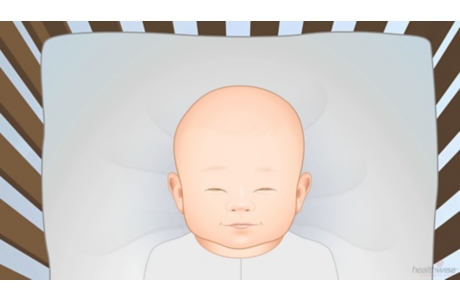Crib Safety
Overview
What are crib safety standards?
Strict guidelines for crib construction help prevent many accidents. If a crib doesn't meet current safety standards, your baby may be injured.
A properly constructed crib has:
- Less than 2.375 in. (60 mm) of space between slats. This prevents a child's head from becoming trapped.
- No cutout designs or spaces if there is an otherwise solid headboard or footboard. A child's head, hands, arms, or legs can get stuck.
- No corner posts. Clothing can attach to these posts and injure or strangle a child.
- Tight and secure screws, bolts, and other construction materials. Check these parts every week. A physically active child can loosen these parts, and the crib can collapse.
- Lead-free paint. Older cribs may have paint that has lead in it. Babies can get lead poisoning from chewing and gnawing on a crib with lead-based paint.
Don't use an old crib. And if a crib has missing or broken parts, don't use the crib and don't try to fix it yourself. Get a crib that doesn't need any repairs. Go to the U.S. Consumer Product Safety Commission (CPSC) website at www.cpsc.gov to learn more.
Keeping your child safe in a crib
The crib is the one place where babies and young children are regularly left unsupervised. So it's important to be aware of the common crib hazards.
To help keep your child safe, use recommended equipment properly and update features of the crib as your child grows. Go to the U.S. Consumer Product Safety Commission (CPSC) website at www.cpsc.gov to learn more.
Crib-related injuries are also caused by unsafe or improperly used accessories. And injuries can also occur as your child grows bigger.
Here are some ways you can avoid common crib hazards.
- Use only mattresses designed for the crib. You should not be able to fit more than two fingers in the space between the mattress and crib. Also, remove any plastic covering from the mattress.
- Help prevent your child from falling out of the crib, the leading cause of crib accidents, by adjusting the mattress level as your child grows. Start lowering the mattress no later than when your child begins to sit with little help. Adjust the mattress to its lowest setting by the time your baby can stand.
- Keep cribs-as well as all other furniture and large objects-away from windows to prevent serious falls.
- Do not place the crib near drapes or blinds. Window cords can get wrapped around a child's neck. When your child is 35 in. (89 cm) tall, they have outgrown the crib and should sleep in a bed.
- Remove mobiles and activity gyms from the crib by the time your child can push up on their hands and knees or is 5 months of age, whichever comes first. These are strangulation hazards for children who can get on their hands and knees.
- Don't use bumper pads or other products that attach to crib slats or sides. They could suffocate or trap your baby.
- Never use a sleep positioner. Using a sleep positioner to hold a baby on their side or back can be dangerous.
- Keep soft items and loose bedding out of the crib. Items such as blankets, stuffed animals, toys, head-shaping pillows, and regular pillows could suffocate or trap your baby. Dress your baby in sleepers instead of using blankets.
Movable side rails are a safety hazard, and new cribs are no longer made with them. If your crib has the kind of side rail that can be raised and lowered, always raise it and secure it properly when your child is in the crib.
Credits
Current as of: October 24, 2023
Author: Healthwise Staff
Clinical Review Board
All Healthwise education is reviewed by a team that includes physicians, nurses, advanced practitioners, registered dieticians, and other healthcare professionals.
Current as of: October 24, 2023
Author: Healthwise Staff
Clinical Review Board
All Healthwise education is reviewed by a team that includes physicians, nurses, advanced practitioners, registered dieticians, and other healthcare professionals.
This information does not replace the advice of a doctor. Healthwise, Incorporated, disclaims any warranty or liability for your use of this information. Your use of this information means that you agree to the Terms of Use. Learn how we develop our content.



